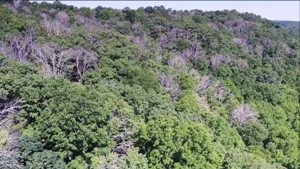
Photo: Troy McCormick
Indianapolis, In. — Today, the emerald ash borer continues to ravage woodlands in every county in Indiana. But the dreaded pest faces ramped-up resistance in the form of treatments funded by a growing group of citizens and organizations.
Now, a $20,000 grant from the Dr. Laura Hare Charitable Trust and additional donations, the Indiana Parks Alliance have topped the initial fundraising goal by raising $28,770 to combat the invasive insect that attacks and destroys ash trees.
The funds will be used in IPA’s Save Our Ash Trees campaign to initially treat 100 mature, seed producing ash trees at several state parks and state nature preserves. EABs have been found in all 92 Indiana counties, and projections point to a potential 95 percent loss of the state’s ash trees over the next decade. “Nothing makes your day like coming home, sitting down at the computer and reading in an email that your organization has been awarded a $20,000 grant for your first major fundraising campaign,” said Tom Hohman, president of IPA, a volunteer organization that supports the missions of the Indiana Department of Natural Resources divisions of State Parks and Nature Preserves.
“This not only allows us to meet our original goal of $20,000 but also gives us reserve funds for necessary retreatments in another two to three years, and to consider expanding the program to additional properties,” Hohman said.
In addition to the Laura Hare grant, IPA received donations of $1,000 from Friends of McCormick’s Creek State Park and the Indiana Native Plant & Wildflower Society, $700 from Friends of Fort Harrison State Park, and $250 from Friends of Limberlost State Historic Site.
Another 33 individual donors made contributions ranging from $10 to $1,000.
“While the $20,000 grant is the big news, it’s important to recognize the other donations,” Hohman said. “All of those donations have made this campaign a great success.”
The SOAT fundraising campaign is ongoing. Visit www.indianaparksalliance.org/save-our-ash-trees/ to donate online.
Emerald ash borers are invasive insects that have destroyed tens of millions of ash trees since arriving in the United States in 2002. Ash trees compose up to 20 percent of Indiana’s private and public forests.
SOAT has identified ash trees at Harmonie, McCormick’s Creek, Shades, and Turkey Run state parks, and at Coal Hollow, Russell Bend, and Shrader-Weaver nature preserves that have been relatively unaffected by EABs.
The trees will be injected with emamectin benzoate, an insecticide that causes insect paralysis. The U.S Forest Service uses emamectin benzoate to control emerald ash borers, and the U.S. Environmental Protection Agency designates it as a reduced risk insecticide. The average cost of treating one mature ash tree is $200.
IPA’s treatment project will bolster an effort begun last year by DNR Nature Preserves, which treated 100 ash trees at nine state-managed properties.



